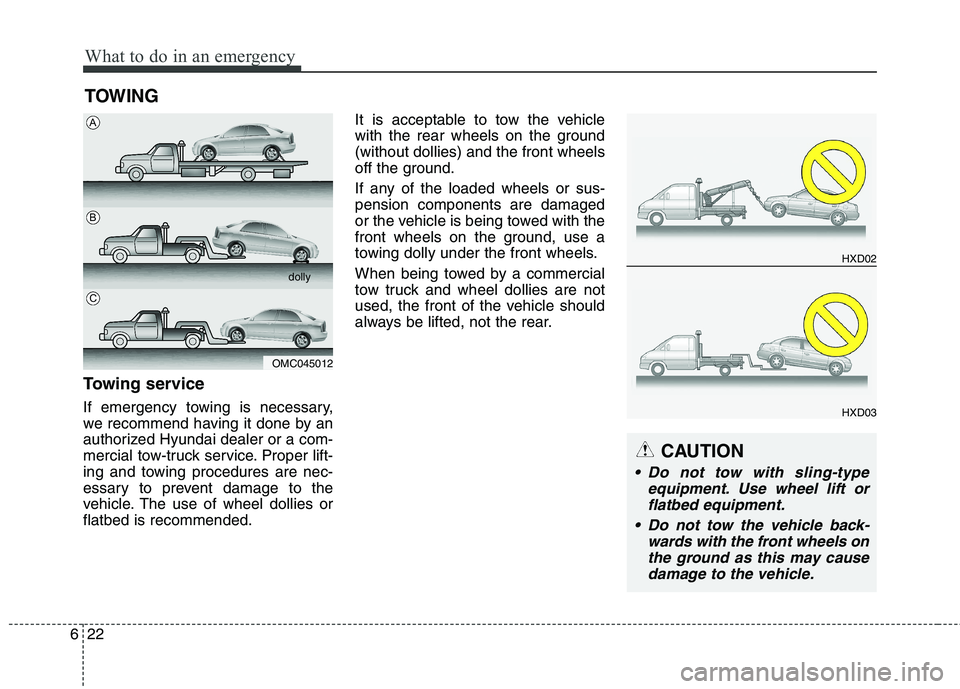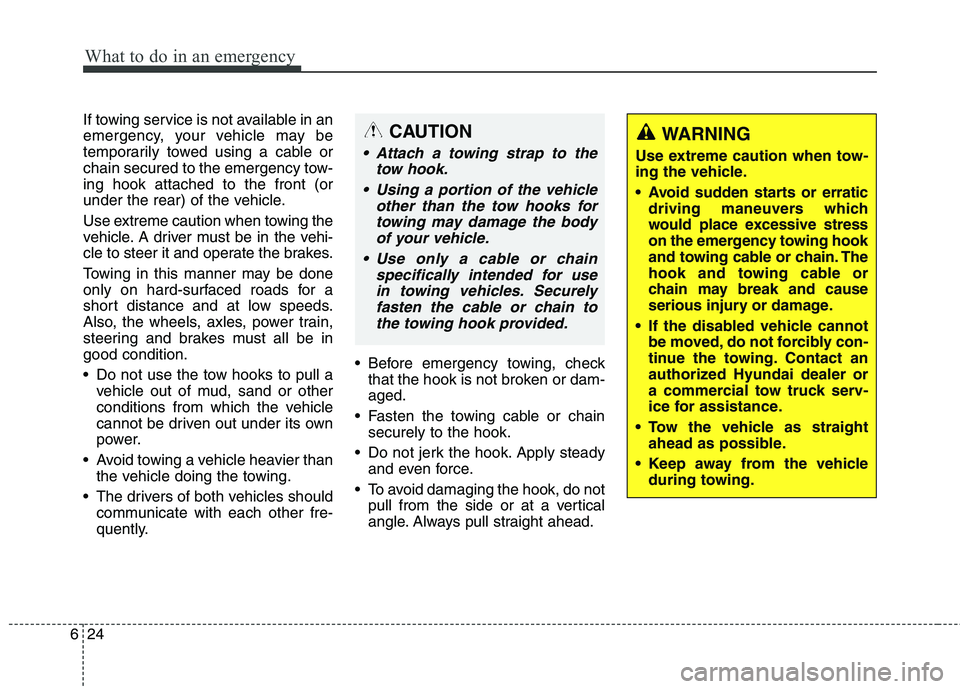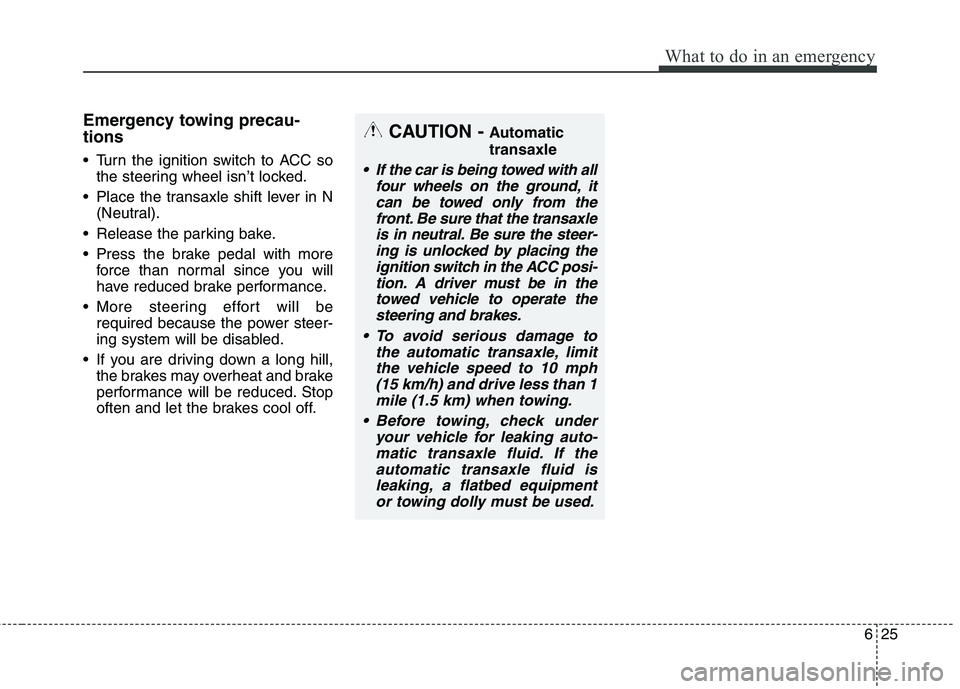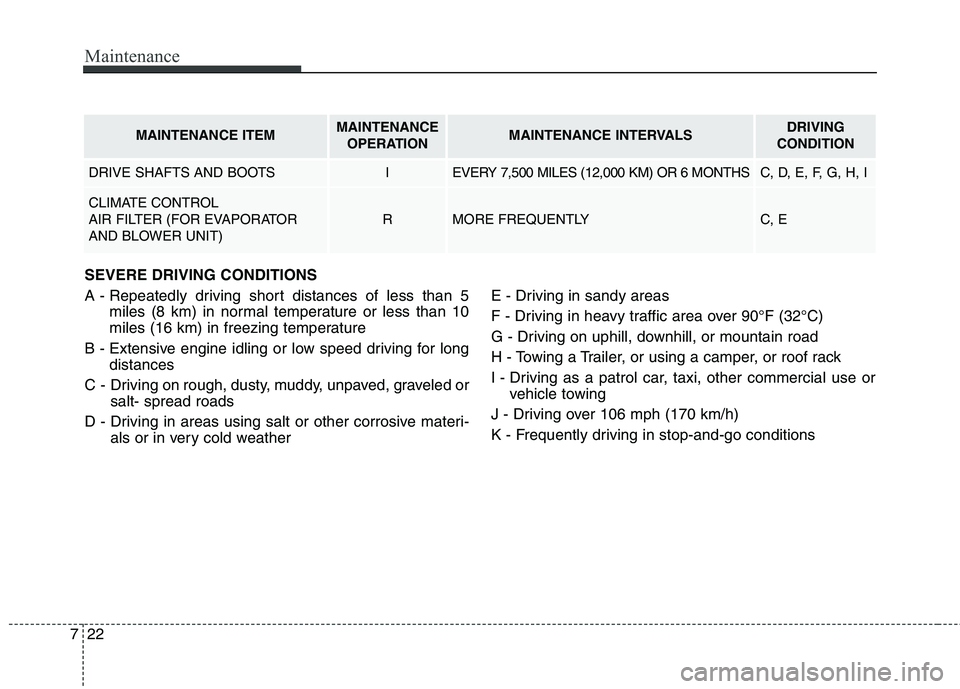2014 HYUNDAI ELANTRA GT towing
[x] Cancel search: towingPage 341 of 476

65
What to do in an emergency
EMERGENCY STARTING
Connect cables in numerical order
and disconnect in reverse order.
Jump starting
Jump starting can be dangerous if
done incorrectly. Therefore, to avoid
harm to yourself or damage to your
vehicle or battery, follow the jump
starting procedures. If in doubt, we
strongly recommend that you have a
competent technician or towing serv-
ice jump start your vehicle.
CAUTION
Use only a 12-volt jumper sys-
tem. You can damage a 12-volt
starting motor, ignition system,
and other electrical parts
beyond repair by use of a 24-volt
power supply (either two 12-volt
batteries in series or a 24-volt
motor generator set).
WARNING - Battery
• Keep all flames or sparks
away from the battery. The
battery produces hydrogen
gas which may explode if
exposed to flame or sparks.
If these instructions are not fol-
lowed exactly, serious personal
injury and damage to the vehi-
cle may occur! If you are not
sure how to follow this proce-
dure, seek qualified assis-
tance. Automobile batteries
contain sulfuric acid. This is
poisonous and highly corro-
sive. When jump starting, wear
protective glasses and be care-
ful not to get acid on yourself,
your clothing or on the car.
Do not attempt to jump start
the vehicle if the discharged
battery is frozen or if the elec-
trolyte level is low; the battery
may rupture or explode.
1VQA4001
Jumper
terminal
Jumper Cables
Booster
battery
Page 358 of 476

What to do in an emergency
22 6
TOWING
Towing service
If emergency towing is necessary,
we recommend having it done by an
authorized Hyundai dealer or a com-
mercial tow-truck service. Proper lift-
ing and towing procedures are nec-
essary to prevent damage to the
vehicle. The use of wheel dollies or
flatbed is recommended.It is acceptable to tow the vehicle
with the rear wheels on the ground
(without dollies) and the front wheels
off the ground.
If any of the loaded wheels or sus-
pension components are damaged
or the vehicle is being towed with the
front wheels on the ground, use a
towing dolly under the front wheels.
When being towed by a commercial
tow truck and wheel dollies are not
used, the front of the vehicle should
always be lifted, not the rear.
OMC045012dolly
A
B
C
CAUTION
Do not tow with sling-type
equipment. Use wheel lift or
flatbed equipment.
Do not tow the vehicle back-
wards with the front wheels on
the ground as this may cause
damage to the vehicle.
HXD02
HXD03
Page 359 of 476

623
What to do in an emergency
When towing your vehicle in an
emergency without wheel dollies :
1. Set the ignition switch in the ACC
position.
2. Place the shift lever in N (Neutral).
3. Release the parking brake.
Removable towing hook
(if equipped)
1. Open the tailgate, and remove the
towing hook from the tool case
which is stored under the cargo
area floorboard.
2. Remove the hole cover pressing
the lower part of the cover on the
bumper.
3. Install the towing hook by turning it
clockwise into the hole until it is
fully secured.
4. Remove the towing hook and
install the cover after use.
Emergency towing (if equipped)
If towing is necessary, we recom-
mend you to have it done by an
authorized Hyundai dealer or a
commercial tow truck service.
CAUTION
Failure to place the transaxle
shift lever in N (Neutral) may
cause internal damage to the
transaxle.
OGD061010
OGD061011
OGD061012
■Rear
■Front
Page 360 of 476

What to do in an emergency
24 6
If towing service is not available in an
emergency, your vehicle may be
temporarily towed using a cable or
chain secured to the emergency tow-
ing hook attached to the front (or
under the rear) of the vehicle.
Use extreme caution when towing the
vehicle. A driver must be in the vehi-
cle to steer it and operate the brakes.
Towing in this manner may be done
only on hard-surfaced roads for a
short distance and at low speeds.
Also, the wheels, axles, power train,
steering and brakes must all be in
good condition.
Do not use the tow hooks to pull a
vehicle out of mud, sand or other
conditions from which the vehicle
cannot be driven out under its own
power.
Avoid towing a vehicle heavier than
the vehicle doing the towing.
The drivers of both vehicles should
communicate with each other fre-
quently. Before emergency towing, check
that the hook is not broken or dam-
aged.
Fasten the towing cable or chain
securely to the hook.
Do not jerk the hook. Apply steady
and even force.
To avoid damaging the hook, do not
pull from the side or at a vertical
angle. Always pull straight ahead.CAUTION
Attach a towing strap to the
tow hook.
Using a portion of the vehicle
other than the tow hooks for
towing may damage the body
of your vehicle.
Use only a cable or chain
specifically intended for use
in towing vehicles. Securely
fasten the cable or chain to
the towing hook provided.
WARNING
Use extreme caution when tow-
ing the vehicle.
Avoid sudden starts or erratic
driving maneuvers which
would place excessive stress
on the emergency towing hook
and towing cable or chain. The
hook and towing cable or
chain may break and cause
serious injury or damage.
If the disabled vehicle cannot
be moved, do not forcibly con-
tinue the towing. Contact an
authorized Hyundai dealer or
a commercial tow truck serv-
ice for assistance.
Tow the vehicle as straight
ahead as possible.
Keep away from the vehicle
during towing.
Page 361 of 476

625
What to do in an emergency
Emergency towing precau-
tions
Turn the ignition switch to ACC so
the steering wheel isn’t locked.
Place the transaxle shift lever in N
(Neutral).
Release the parking bake.
Press the brake pedal with more
force than normal since you will
have reduced brake performance.
More steering effort will be
required because the power steer-
ing system will be disabled.
If you are driving down a long hill,
the brakes may overheat and brake
performance will be reduced. Stop
often and let the brakes cool off.
CAUTION - Automatic
transaxle
If the car is being towed with all
four wheels on the ground, it
can be towed only from the
front. Be sure that the transaxle
is in neutral. Be sure the steer-
ing is unlocked by placing the
ignition switch in the ACC posi-
tion. A driver must be in the
towed vehicle to operate the
steering and brakes.
To avoid serious damage to
the automatic transaxle, limit
the vehicle speed to 10 mph
(15 km/h) and drive less than 1
mile (1.5 km) when towing.
Before towing, check under
your vehicle for leaking auto-
matic transaxle fluid. If the
automatic transaxle fluid is
leaking, a flatbed equipment
or towing dolly must be used.
Page 383 of 476

Maintenance
22 7
MAINTENANCE ITEMMAINTENANCE
OPERATIONMAINTENANCE INTERVALSDRIVING
CONDITION
DRIVE SHAFTS AND BOOTSIEVERY 7,500 MILES (12,000 KM) OR 6 MONTHSC, D, E, F, G, H, I
CLIMATE CONTROL
AIR FILTER (FOR EVAPORATOR
AND BLOWER UNIT)
RMORE FREQUENTLYC, E
SEVERE DRIVING CONDITIONS
A - Repeatedly driving short distances of less than 5
miles (8 km) in normal temperature or less than 10
miles (16 km) in freezing temperature
B - Extensive engine idling or low speed driving for long
distances
C - Driving on rough, dusty, muddy, unpaved, graveled or
salt- spread roads
D - Driving in areas using salt or other corrosive materi-
als or in very cold weatherE - Driving in sandy areas
F - Driving in heavy traffic area over 90°F (32°C)
G - Driving on uphill, downhill, or mountain road
H - Towing a Trailer, or using a camper, or roof rack
I - Driving as a patrol car, taxi, other commercial use or
vehicle towing
J - Driving over 106 mph (170 km/h)
K - Frequently driving in stop-and-go conditions
Page 475 of 476

I9
Index
Tachometer ....................................................................4-57
Tailgate ..........................................................................4-25
Tether anchor system ....................................................3-34
Theft-alarm system........................................................4-17
Tilt steering ..................................................................4-44
Tire and loading information label ..............................5-58
Tire chains ....................................................................5-55
Tire pressure monitoring system (TPMS) ......................6-9
Tire specification and pressure label ..............................8-9
Tires and wheels............................................................7-44
Checking tire inflation pressure ................................7-45
Compact spare tire replacement ................................7-49
Recommended cold tire inflation pressures ..............7-44
Tire care ......................................................................7-44
Tire maintenance ........................................................7-49
Tire replacement ........................................................7-48
Tire rotation ................................................................7-46
Tire sidewall labeling ................................................7-50
Tire traction ................................................................7-49
Wheel alignment and tire balance ..............................7-47
Wheel replacement ....................................................7-49
Tires and wheels..............................................................8-4
Towing ..........................................................................6-22
Towing capacity ............................................................5-59
Trailer towing ................................................................5-64Transaxle
Automatic transaxle....................................................5-17
Manual transaxle ........................................................5-14
Trip computer ................................................................4-61
Automatic transaxle shift position indicator ..............4-60
Manual transaxle shift indicator ................................4-60
Outside temperature ..................................................4-60
Vehicle break-in process ................................................1-5
Vehicle capacity weight ................................................5-58
Vehicle certification label................................................8-8
Vehicle curb weight ......................................................5-63
Vehicle data collection and event data recorders ............1-6
Vehicle identification number (VIN) ..............................8-8
Vehicle load limit ..........................................................5-58
Cargo capacity ............................................................5-59
Certification label ......................................................5-61
Seating capacity..........................................................5-58
Steps For Determining Correct Load Limit ..............5-59
Tire and loading information label ............................5-58
Towing capacity..........................................................5-59
Vehicle capacity weight..............................................5-58
Vehicle stability management ......................................5-38
Vehicle weight ..............................................................5-63
Base curb weight ........................................................5-63
Cargo weight ..............................................................5-63
T
V